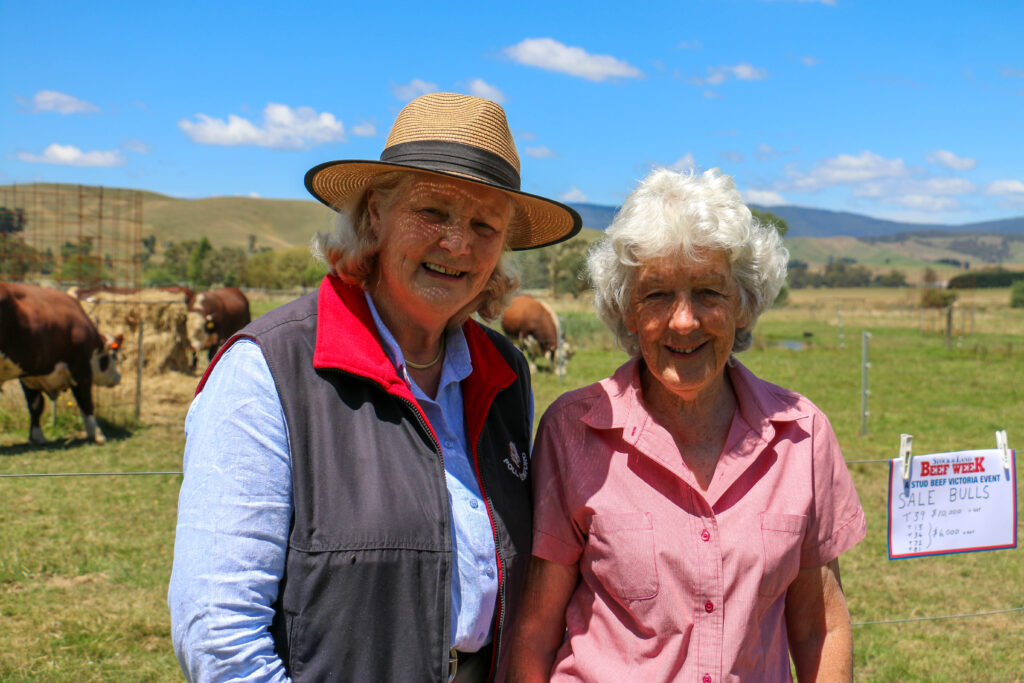Lynn and Pam Vearing have been instilling resilience in their Hereford herd and business for more than five decades, enabling them to ride out both good and challenging times.
The Victorian couple has bred Herefords for 54 years and rather than transitioning into retirement, they expanded their footprint, stepping up to purchase the historic 308ha Glenburn Station two years ago along with a property at Whittlesea.
There is no stopping this energetic couple who have consolidated their five properties into three to increase management efficiency.
Glenburn Station, Glenburn, boasts extensive capital infrastructure, plentiful water and improved pastures, and is home to both their Glen Goulburn stud and commercial cattle.
The stud had been based on a property at Epping bought by Lynn’s grandfather a century ago, but Melbourne’s urban sprawl resulted in the family looking further afield for acreage.
In the past, Lynn and Pam have run Shorthorn, Angus, crossbred and dairy cattle but have always appreciated the doing ability of the Hereford breed in challenging climatic conditions.
“We run 200 stud and commercial cows at Glenburn – this is a conservative figure as it allows us to easily manage the cattle, look after the environment and improve this farm,” Lynn said.
Managers Mark and Linda Ashton will be planting 1500 trees this year along the waterways and creeks on Glenburn Station to stabilise the soils, create stock shelter and increase biodiversity.
“We’ve already started to plant individual trees around the paddocks for shade. When we soil tested the property it was high in phosphorus so over the last two years, we have put on heavy rates of lime,” Lynn said.
“Sustainability means getting the soil right – we can see the difference where single super has been applied at 250kg/ha and the cattle have benefitted from it. This area is bad for grass tetany, and we have avoided that through the lime applications.
“Achieving sustainability through livestock health makes a big difference to the bottom line.”
Lynn is keen to explore information on sequestering carbon and earning carbon credits, although he would be selective about selling carbon offsets to companies without an environmentally sustainable business model.
The first step for producers is to establish the required baseline measurement of carbon emissions per kilogram of beef produced.
A carbon account can be used in on-farm decision making and sets a benchmark to show progress over time.
Lynn believes productivity in a beef herd is focused on cow fertility and longevity.
“I’m not a person who has a young herd and keep turning it over. By maintaining longevity, you can understand the structure of cattle – those with good feet and structure who survive certainly put a lot more productivity in the herd,” he said.
“I like experimenting with genetics to see how the progeny grow out, calve down and milk, along with their feet and structure.”
He said breeding was about balancing calving ease with growth to increase productivity.
“Feed efficiency is hard to measure as seasons change from year to year, but those big, framed cows struggle in tough times. Moderate framed cows are the ones who get in calf a lot easier. We have to be careful of not going too small in mature cow frame size as higher growth rates are needed in the progeny from 12 to 24 months when finishing on pasture or grain.”
Glen Goulburn sells around 100 heavy steers each year finished on cereal and forage crops, or grain, drafting them into sire lines before sale.
“It’s pretty obvious then which sires are more or less productive. With the steers being grown out to bullocks, I can learn a lot about their structure and finetune the cattle I produce in the future,” Lynn said.
“Growing steers out to 18 to 24 months on a good crop of oats, sorghum or grass I have found to be more profitable than selling the steers as weaners.”
Lynn has created resilience in his business by using conservative stocking rates.
“I like to have enough feed in the good years to look after the bad years without having to buy in a lot. When necessary, buying grain is cheaper than hay (grain has more metabolizable energy than hay) – if cows are kept in fat score three or above most of the year it is the easiest way to combat tough times.
“With Herefords, we know we can run them a bit tougher in the winter because in the spring they will rebound so quickly on a bit of feed.
“We have been breeding Hereford cattle for over 50 years, enjoyed every minute of it and hopefully we can enjoy a lot more of it.”
- Meat and Livestock Australia has launched an online, web-based Carbon Calculator based on the Sheep and Beef Greenhouse Accounting Framework tool for Australian beef and sheep producers. For more information visit mla.com.au/tools-calculators or to access more sustainability tools at mla.com.au/sustainability-hub

Glen Goulburn Herefords co-principal Lynn Vearing with commercial Hereford breeders Lloyd and Andrew Nutbean, Govur, during Beef Week.

Glen Goulburn manager Mark Ashton and co-principal Lynn Vearing with commercial Hereford/Shorthorn breeders Malcolm and Dianne Towt, Yarra Glen.

Glen Goulburn co-principal Pam Vearing and Lyn Mullens, Dixons Creek. Lyn finishes her Hereford steers to 700kg liveweight for the Greenhams Never Ever program and operated Mulbryn Poll Herefords until 2009.






